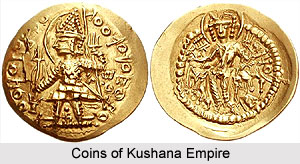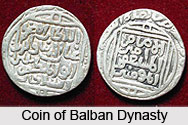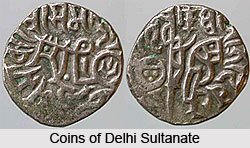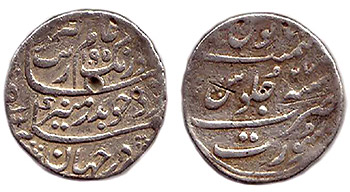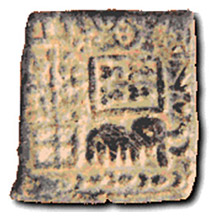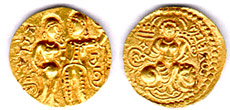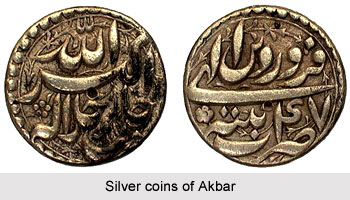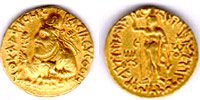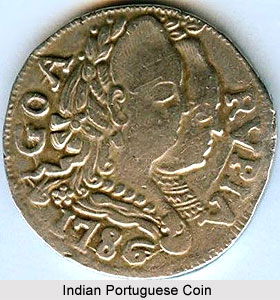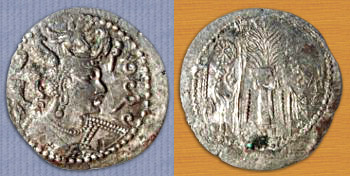 The Hunas who were also called `Ye-tha` or `` and migrated from their homeland and moved westwards, were the issuer of coins that showcases the artistic excellence of the by-gone days. After forming two main streams, one branch of the Hunas crossed the Hindukush, and occupied Gandhara. Afterwards they paraded towards the territories of the Gupta Empire. The progression of the Hunas was halted by the Skanda Gupta. Later during the invasion of Persia, the Persian king was defeated and killed by the Hunas. Thus, the Hunas succeeded in building up a vast empire in the territory. After being the overlord of a huge territory, the Hunas by the end of the fifth or the beginning of the sixth century A.D., moved towards India. During this time, advancing from the Punjab under the leadership of Toramana, they conquered a large part of Western India and Malwa. After occupying a huge dominion, the Hunas thought of issuing coins of their own.
The Hunas who were also called `Ye-tha` or `` and migrated from their homeland and moved westwards, were the issuer of coins that showcases the artistic excellence of the by-gone days. After forming two main streams, one branch of the Hunas crossed the Hindukush, and occupied Gandhara. Afterwards they paraded towards the territories of the Gupta Empire. The progression of the Hunas was halted by the Skanda Gupta. Later during the invasion of Persia, the Persian king was defeated and killed by the Hunas. Thus, the Hunas succeeded in building up a vast empire in the territory. After being the overlord of a huge territory, the Hunas by the end of the fifth or the beginning of the sixth century A.D., moved towards India. During this time, advancing from the Punjab under the leadership of Toramana, they conquered a large part of Western India and Malwa. After occupying a huge dominion, the Hunas thought of issuing coins of their own.
The coins of the Hunas were the imitation of the coinage of the territories which they conquered. They borrowed the Sassanian type in Afghanistan and these Huna coins were called the `Hepthalo-Sassanid`. The coins were decorated with the figure of the king bedecked with a head dress, which was adorned with buffalo head and wings on either side. These coins were struck again and the patterns of the coins were redone. When the coins were struck, the reverse side of the coin showing a fire altar with attendants was almost obliterated. But this partial or total effacement was the result of the use of a special striking technique. Bi-faced coins were normally stamped by the simultaneous use of obverse and reverse dyes. The dye was done on a special way. The reverse dye was stamped first and no protection was given to the impressed side. Immediately after that the coin was placed on the anvil and the obverse dye was struck. These Hepthalo-Sassanid coins were monolingual, having Pahlavi or Indian Brahmi inscriptions, bi-lingual that had Pahlavi and Hepthalite inscriptions and tri lingual that had Pahlavi, Hapthalite and Indian legends.
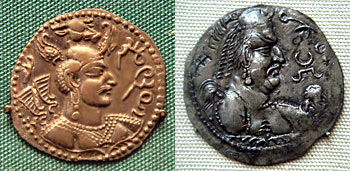 The coins of Hunas include the gold and silver coins those were finely executed and bore the name in Pahlavi and which were read as `Napki`, `Naapki`, `Neski` or `Nezaki`. Some of the coins also had the title `Maleka` that means king. On a few coins the Brahmi legends were etched as `Sri Yadvi`, `Mana Sri`, or `Vasu Vangara`. Some of the coins issued during this period were named as `Zabulistan` (the land of Zabuluas or the Hunas). The coins depict a figure with a fire nimbus in place of the motif of fire altar with attendants on the reverse side of the coins. According to the earlier scholars, it represented the Sun god of Multan or Maitreya Bodhisattva but actually the figure was feminine and represented `Khurasan Zarrah` (the glory of Khurasan), the city goddess. It has been considered that this motif was borrowed from the later Sassanid coins.
The coins of Hunas include the gold and silver coins those were finely executed and bore the name in Pahlavi and which were read as `Napki`, `Naapki`, `Neski` or `Nezaki`. Some of the coins also had the title `Maleka` that means king. On a few coins the Brahmi legends were etched as `Sri Yadvi`, `Mana Sri`, or `Vasu Vangara`. Some of the coins issued during this period were named as `Zabulistan` (the land of Zabuluas or the Hunas). The coins depict a figure with a fire nimbus in place of the motif of fire altar with attendants on the reverse side of the coins. According to the earlier scholars, it represented the Sun god of Multan or Maitreya Bodhisattva but actually the figure was feminine and represented `Khurasan Zarrah` (the glory of Khurasan), the city goddess. It has been considered that this motif was borrowed from the later Sassanid coins.
In the later years of their reigning period, the Hunas issued the later Kushana type coins in Kashmir and the silver Gupta type coins in some other places in India. Nothing bears witness about their issuing of gold coins but it had been evidenced that they issued coins in copper and silver. The Huna kings Toramana and Mihirakula both issued silver coins that were of Sassanian bust type and these coins show a coarse impression of the bust of the king to the right on the obverse side of the coin. The reverse side of the coin bore the Sassanian fire-alter with its two attendants. The coins of Toramana bore his title `Sahi Jabuvalah` or coins `Jabula` in Gupta-Brahmi and did not disclose his name. The coins issued during the period of Mihirakula bore his name `Jayatu Mihirakula` and sometimes the coins only inscribed only the title `Jayatu Vrishadhavaja`. The historical evidences say that Toramana also issued silver coins of two other types. One of the coins follows the Sassanian tradition for its reverse side of the coin and had the fire-alter with the two attendants and also adopted a new obverse that manifested a horseman. The legend of the coins was `Sahi Jabula` or `Sahi Janabula`. The other type of coin closely followed the Gupta silver coins of the eastern region with the difference that the king`s head was turned to the left. The reverse side of the coin had the fantailed peacock and the legend where the only change of name was done.
In various parts of northern India, specially in Rajasthan and Malwa, some un inscribed silver coins with crudely executed Sassanian bust and fire-alter were found. The copper coins that were found in the eastern Punjab and Rajasthan and attributed to Toramana. These coins bore the king`s head of the Sassanian type on the obverse side of the coin and the sun wheel with the name `Tora` or `Zoboa` or `Jabula` on the reverse side of the coin. He also issued copper coins of the Gupta archer type. These particular coins closely copy the obverse and the reverse and only difference was in the inscription. Even there were a large number of copper coins of the Kidara Kuahana type which were found majorly in Kashmir. The obverse side of the coin bore the standing king with the legend `Sri Toramana` and a crudely executed Ardokhso holding a lotus with the legend `Kidara` on the reverse side of the coin.
The coins of Hunas include the coins of Mihirakula as well which are found to be of three types. The large copper coins portray the king riding a horse on the obverse and Lakshmi on the reverse side of the coin. The historical evidences depict that these patterns of the coins were copied from the Gupta horseman type. The second type of coin followed he coins of the Later Kushanas. The third type of the coins was the Sassanian type with the king`s bust on the obverse and a humped bull on the reverse. Some of eh coins appeared to be counter struck and thee coins were found in Punjab. As per the scholars, they were the coins of Mihirakula counter struck with the legend of Toramana. But according to some other people, these coins were the coins of Toramana counter struck with the device and legend of Mihirakula.
The coins of the Hunas stand model of the Huna kings as the kings used to amalgamate their own patterns with the patterns they developed from other dynasties. Sometimes the patterns of the coins were taken from the territories which come under their power.
